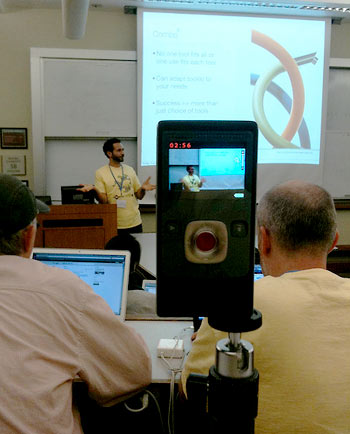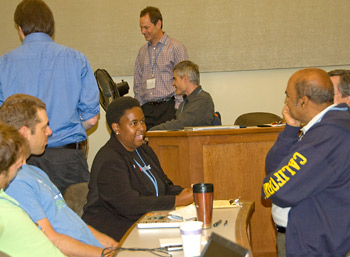Cal Educamp explores the nexus of new technology and teaching
How can educators use emerging digital technologies to excite students and spur learning? At Cal Educamp — a participant-driven "unconference" held on campus Aug. 5 — teachers, students, instructional designers and researchers re-imagined education for the 21st century.
August 8, 2011
As befits a free-form “unconference” on potential uses of new digital technologies for teaching and learning, participants in Friday’s Cal Educamp tweeted live reactions using the Twitter hashtag #caleducamp. A few examples: “Wikipedia session reminds me of Colbert elephants (in a good way).” … “One kind of Digital Citizenship: ‘How do we act appropriately and ethically in a 21st century environment, & with social media?'” … “Cal Professor Maggie Sokolik talking Facebook for higher education course. Very cool.”

Nathan Gandomi presenting at Educamp (Bobby White/Flickr photo)
Some 75 teachers, instructional designers, students and researchers from the campus and beyond converged at the Haas School of Business to think aloud and collectively about best pedagogical practices harnessing the Web 2.0 tools — from photo sharing to social bookmarking and microblogging — that are capturing the imagination of new-generation digital natives.
“It’s hard to figure out how to best use new technology so it’s not destructive to the learning experience,” said participant James Fung, a grad-student instructor in electrical engineering. While his students are good at memorizing math tools, he said, they’re not always good at using those concepts and formulas efficiently to solve novel problems. Are there digital tools he might use, he wondered, to help bring students to the next level — without falling into the “let’s use it ’cause it’s new” trap?
Hosted by Education Technology Services (ETS), the iSchool’s Center for Next Generation of Teaching and Learning (NGTL) and the Center for Teaching Excellence at Haas, the Aug. 5 event had a fast, loose feel and a participant-driven format that mirrored many of the digital tools in question. No more “sage on the stage,” declared NGTL program director Nathan Gandomi, an Educamp organizer. Instead, participants collectively created the agenda; some signed up to lead impromtu sessions.
The day ultimately offered a mix of pre-planned and spontaneous sessions. Independent scholar Harold Rheingold popped up on participants’ laptops, via videochat, to advocate for a “new culture of learning” that re-imagines the classroom environment and the roles of teachers and students. Rheingold has explored this social-media-rich, inquiry-based “active-learning” paradigm as an iSchool lecturer, and is slated to visit the topic at Berkeley next spring as a UC Regents’ Lecturer.

Downloading and uploading ed-tech ideas. (Cathy Cockrell photo)
Middle-school technology facilitator and San Francisco State University instructor Jeff Brain demonstrated how he’s used comic-book authoring — with students using simple digital-graphics tools to turn out high-quality illustrations — to teach topics across the curriculum. Other workshops drilled down on the digital divide, mobile apps, social-media practices and more.
Participants had been encouraged, prior to Educamp, to set up accounts (if they hadn’t already) with Twitter, Picasa, YouTube, WordPress, delicious and other Web 2.0 tools, so they’d be ready to experiment in real time at the “unconference.”
“Now reading: Facebook’s facial-recognition system, why it’s scary: http://bit.ly/nUnWNk via @CBSNews #caleducamp,” tweeted one participant. “Observation: Most of the folks in the twitter ice breaker were female. Most in assessment workshop male,” wrote another. Others uploaded photos to Flickr or liveblogged their reflections.
“Many educators are wondering how Google’s new social networking environment, Google+, is going to solve some of the privacy questions associated with Facebook, while still allowing classes and groups in classes to organize and be visible among themselves,” graduate student Dave Malinowski wrote on the Berkeley Language Center blog Found in Translation.
Educamp is part of an ongoing campus effort to push the new-technology-meets-teaching envelope. This fall, ETS plans to offer a seminar for faculty that will delve into the intellectual roots of Web-based technologies, require participants to use digital tools and be held in a new “active-learning test kitchen.”
“A lot of faculty can’t do all that they want to do in bSpace,” noted ETS instructional designer Bobby White, an Educamp organizer. The seminar will include both in-class and online components. And rather than leading with shiny tech toys, she said, “we’ll try to get to what their learning goals are, and then find tools to meet those goals.”
Related information: Berkeley scholars’ adventures in the blogosphere (NewsCenter, 2009)